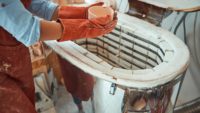Design-build projects often present interesting challenges, and Tiller’s Garage Service Center would prove to be no exception, except for the unique and unpleasant challenge presented near the project’s end.
Design-build also means we are accepting 100% responsibility for the PHVAC design, implementation and commissioning. The end results also depend on other trades performing their piece of the building puzzle properly. The Tiller garage posed a number of unique challenges, not the least of which was a ceiling-suspended 500,000-Btu/h Clean Burn waste oil heater. The idea was that all the used motor oil and other flammable automotive fluids would be deposited into the 500-gallon oil tank for “free” heating of the 6-bay service area, and a place where homeowners could drop off used motor oil.
Waste oil burners are very similar to standard oil burners using #2 fuel oil, but also differ in several ways due to the viscosity and contaminants found in used motor oil along with hazardous heavy metals left behind that are removed during cleaning of the heat exchanger (requires NIOSH full-face respirator with filters, gloves and impermeable full-body suit).
We were factory-trained and certified by Clean Burn. Two major differences are the nozzle, which has a larger bore to allow post-filtration particulate to pass through, and the compressed air utilized to atomize the oil mixture for clean combustion. Weekly flame adjustment is required due to changing viscosity, and designated Tiller employees were trained onsite. Two gas-fired unit heaters served as backup. The offices were located along the west-facing wall with a parts storage area above. This would turn out to be the bone of contention.
A gas-fired high-efficiency furnace was to serve the open-to-the-rafters waiting room/sales desk area with large double-pane glass walls facing south and east (no external or internal shading), the four offices and hallway, plus the parts storage area. All ductwork was to be installed just below the open-truss bar joists, and our design incorporated three zones with motorized trunk-duct dampers. The supply/return plenums were equipped with a weighted bypass damper to ensure proper airflow across the heat exchanger and AC coil. AC was to be sized for the offices and customer/sales desk areas only (per the Tillers instructions). R-5 high-density insulation was to be installed below the first 5 feet of exterior wall concrete slab-on-grade concrete floors, and extended down to the footers. Exterior walls were to be R-19 with the office ceiling area to be R-11 (limited space due to other trades), and all roof areas to be R-10 between deck and rubber membrane roofing.
For the Manual-J light commercial calculations, we were faced with a multitude of challenges regarding this operation: large garage doors opening/closing (owners rejected radiant heating due to budgetary limitations, which no one knew they were going to exceed anyway). But here, at least, the Clean Burn and unit heaters could react to offset any heating issues; customer area with large solar gain and doors opening closing; office area — but here we decided that Mrs. Till-er, who was an imposing figure and certainly wore the pants in that family, would have the thermostat in her center office with its largest west-facing window; and the most stable environment and easiest to control — the parts storage area with no windows.
All ductwork trunk and duct lines were internal-lined metal with all joints sealed with fiberglass mesh tape and mastic to avoid leakage. Run outs were 10 feet or less, using UV-resistant R-8 flex duct. Airflow was tested using our Alnor Bolometer air hood to ensure we had the system balanced and adjusted to the Manual-J CFM specifications. Commissioning was done, so we thought, until Mrs. Tiller came charging at us like an enraged bull! Yikes, what burr was in her saddle? Seems Mrs. T found her room temperature to be too hot in the summer’s heat, and was certain she would be too cold in winter. Mr. T, being no fool, backed her 100% and they were threatening to sue. Like a rollercoaster, that first precipitous drop was a doozy and all goodwill was left behind on the ride’s platform. Just for fun, the builder joined the fray, taking the Tillers’ side.
Pays to know an engineer
Back to the drawing board to review my Manual-J and -D calculations where I could find no errors. Back to the Tiller Service Center offices looking for clues where my lead tech hollered for me to come to Mrs. Tiller’s office. “Here, lie down on the floor and look at the base of the wall and tell me what you see.” Good grief: daylight! You could also feel a noticeable draft along the base of the exterior wall in every one of the four offices. A lit match held at floor level adjacent to the rubber-base molding would be blown out. Exfiltration/infiltration wildly exceeding any reasonable air exchange input for the Manual-J calculations. It was blatantly obvious to me that the fickle finger of fate should now point to the builder, whose subpar construction was at fault. We met with both Tillers in her office and they both blew their tops. Hey, don’t shoot the messenger, I said, but that clearly fell on deaf ears!
What we did not, and could not, know at that time was the Tillers were overextended financially, and had a very compelling reason to find any means to avoid paying someone. Given that mechanicals often comprise 30% to 50% of a project’s budget, we were the bright shinny object. The builder, naturally, scoffed at the notion that his work was suspect.
So, I did the only rational, wise and sensible thing that could be done: I hired a mechanical engineer from a venerable and highly respected local firm. But first, I called one of their mechanical engineers who often relied on me for design assistance with radiant heating projects. He agreed it should be one of their mechanical engineers I did not know, and had not worked with prior to this issue. I submitted the architectural drawings and my HVAC calculations, and once he had reviewed the information, a site visit was scheduled. Onsite, he thoroughly inspected the three-zone system, took his own CFM measurements, and concluded our system was spot-on. He pro-vided me with an official report verifying there was nothing wrong with our design and installation. Silly me — I figured that would suffice to settle the dispute and we would be promptly paid. No dice.
The only remedy remaining was to sue the Tillers. Our star witness was the mechanical engineer. The Tillers only witness was the builder, who suffered a withering interrogation by our attorney and had to admit, under oath, that his framing and insulation subcontractors had not properly sealed the base plate of the exterior walls, which was why we could see daylight and feel the draft.
Here again, having a professional mechanical engineer there with us to confirm these issues from his site visit was worth its weight in gold because we emerged reputation intact (priceless), and did, in fact, get paid.
A year later, the Tillers went belly up, lost their lakeshore home and boat, and faded off into the sunset.




